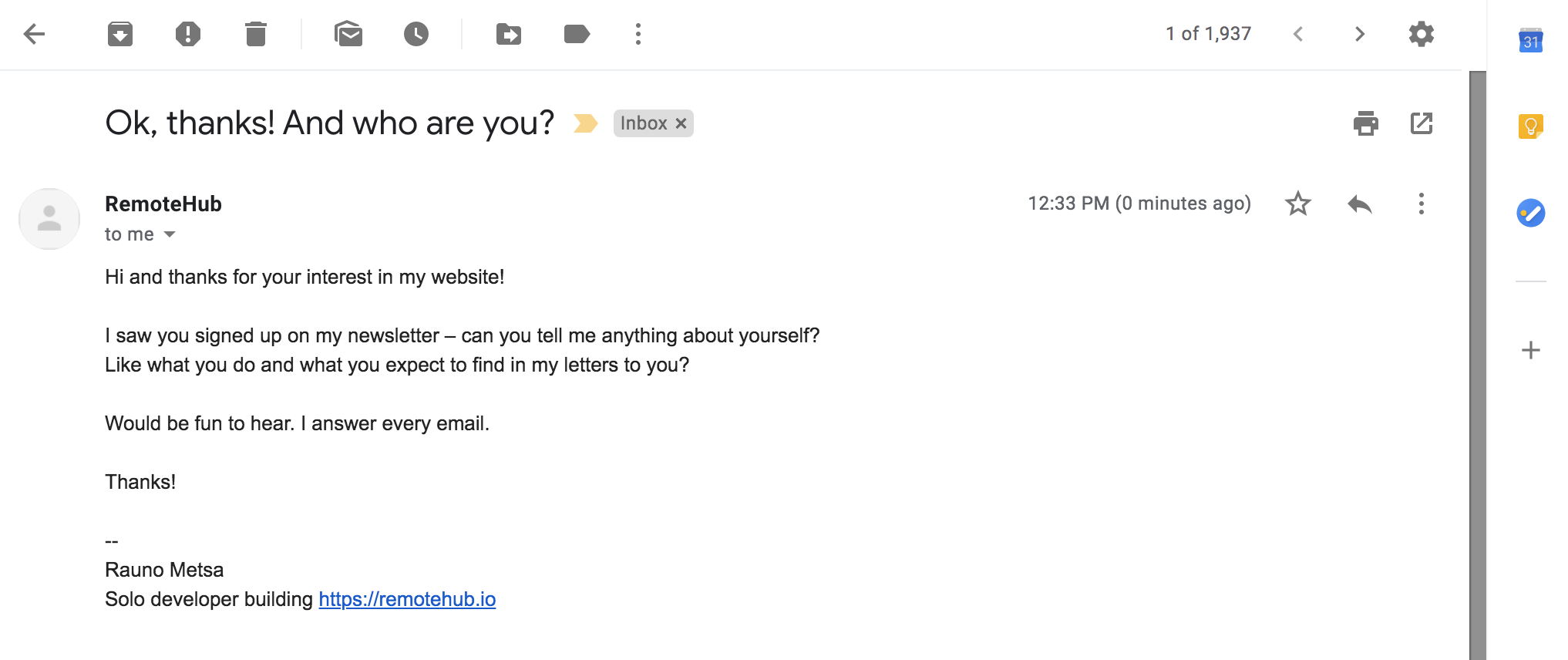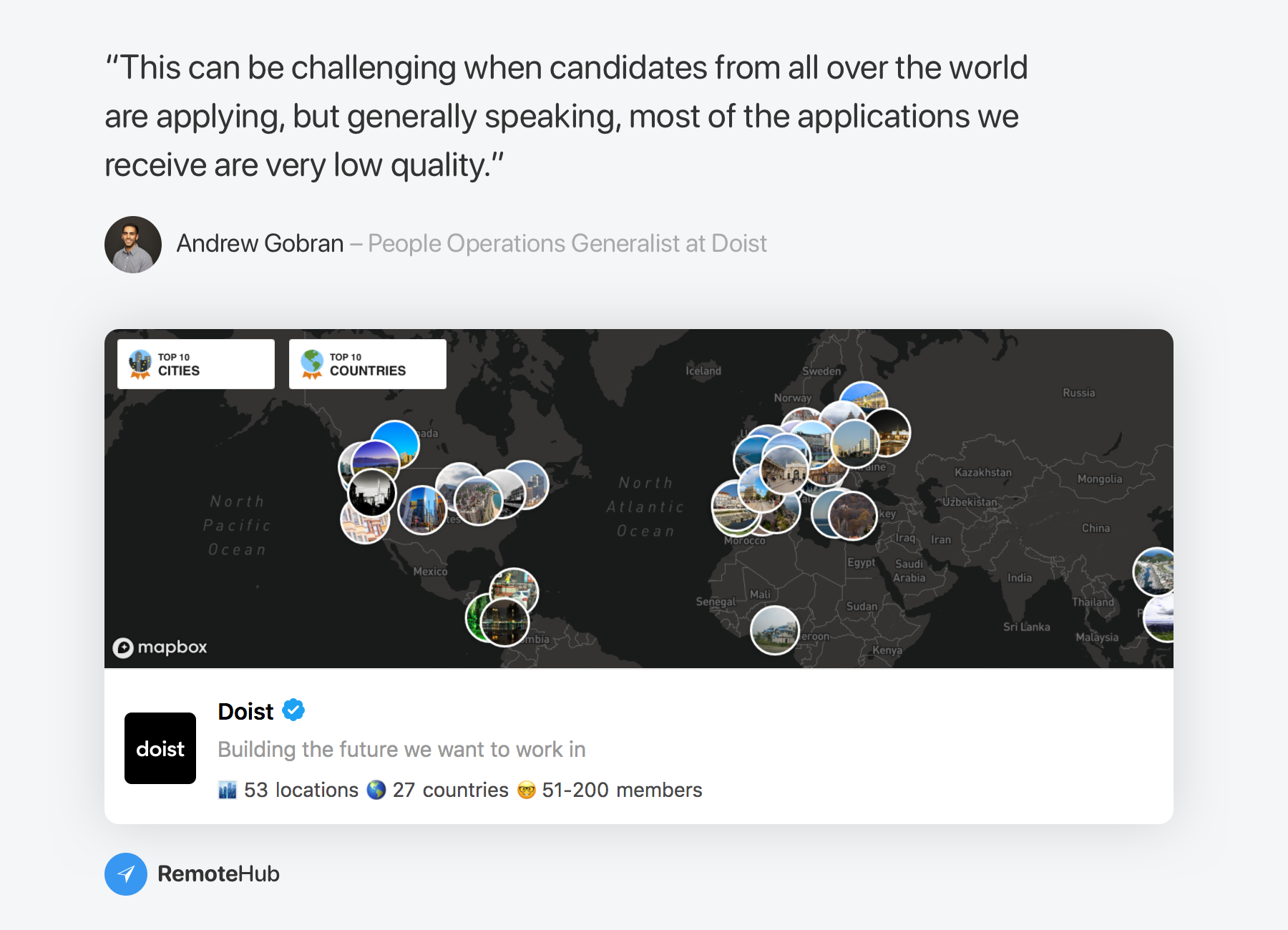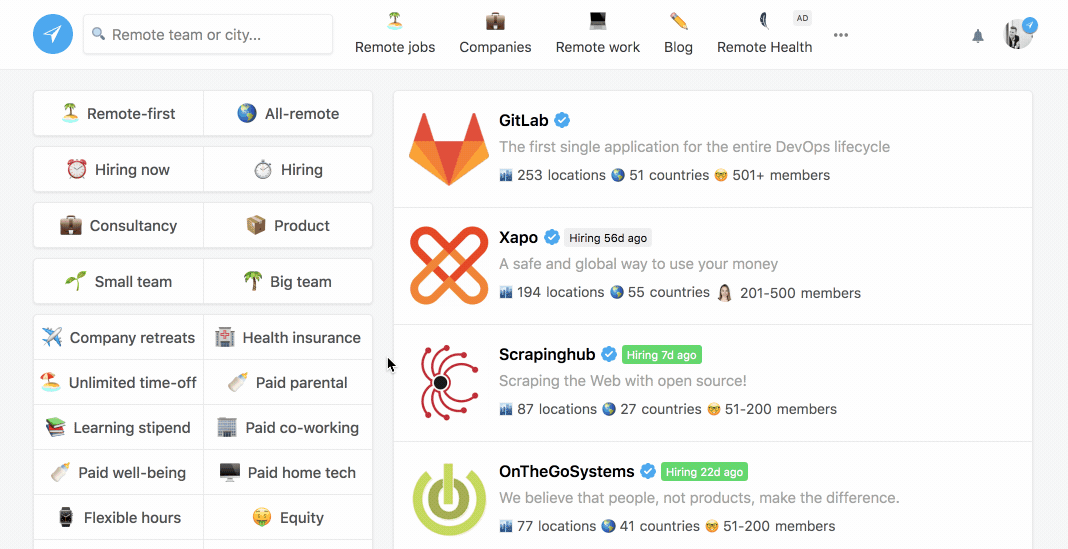By Rauno Metsa
I’m a solo developer bootstrapping RemoteHub – a place to discover the best remote jobs and learn about remote work from the leading distributed teams.
While building RemoteHub, I've been talking to a lot of remote company managers about how they hire remotely. And yes, it can be super hard to get a remote job. The fact is, there are probably hundreds of people applying from all over the world for the same position.
Take Doist, for example – an all-remote company behind the popular productivity apps Todoist and Twist. Their employees work from almost 30 countries across the globe. They received 13,730 remote job applications in one year and hired 18 people (0.13%). That seems like a crazy competition.
And it makes sense. When you're hiring remotely, the talent pool is so much bigger than for office jobs. A lot of people want to work remotely for its benefits like working from home on a flexible schedule. This means that a lot more people apply.
COVID-19's effect on new remote jobs
And now this coronavirus! Are companies hiring at all?
Well of course we don’t know what the effect will be in the long term, so we can only see what’s happening right now.
But I’ve been looking at remote jobs posted on the most popular job boards, and currently I don’t see much change other than this weird jump on Stack Overflow a few weeks back. I don't know what was up with that.
 See the live graph. Data is based on public RSS files from these job boards. WWR data doesn't include every category, only the most popular (programming, design, marketing and support).
See the live graph. Data is based on public RSS files from these job boards. WWR data doesn't include every category, only the most popular (programming, design, marketing and support).
There’s maybe a slight decrease in new job posts, but it didn’t drop a lot when the world went to a lockdown. And there are probably more companies who were forced to stay at home and will continue to work and hire remotely.
So I wondered...How can I help?
I’ve set up this automated email that asks people to tell me something about themselves, like what they do and how my website can help them.

Around 20% answer. Some are managers from remote companies and they are setting up their profile. But most are looking for a remote job, and many of them are struggling with COVID-19 consequences recently.
There are people whose work involves some large groups of people, like theater artists, and they’re living from their savings. They’re hoping to find a remote job to work from home.
Others have lost their job as the company is struggling to pay their salary.
People often ask me how they can increase their chances of getting a remote job. I wanted to help, and so I talked to 30 remote companies who gave me 230 answers about what they look for in a remote jobs candidate, what their hiring process is like, and how they work as a distributed team.
Here are the main things that stood out to me.
Show your genuine interest in working at the remote company
Doist is one of the thought leaders in the remote community. I wanted to know how one could stand out of these 13,730 candidates. So I asked Andrew Gobran, who is the People Operations Generalist at Doist.

“This can be challenging when candidates from all over the world are applying, but generally speaking, most of the applications we receive are very low quality,” Andrew said. “Focusing on crafting a high-quality application that has an organized resume, thoughtful responses, and demonstrates that you are genuinely interested in joining Doist.”
People reading your application will notice if you really want to work on their team, or you’re just sending out tens of CV-s every day to see if you get a reply.
This is also confirmed by many other managers, like Laura de Figueiredo from OnTheGoSystems whose distributed team works from 40+ countries: “When we see an application is not just something massive that was copy-pasted but that the candidate took the time to customize the application for the specific role our company offers, the candidate will surely stand out.”

Do your research
When a company posts a remote job to a jobs board, there’s a lot more candidates applying for the position because of the traffic the post gets.
But posting a job to a jobs board isn’t the only way companies are hiring.
Find remote companies you’d like to work at. Read their blog, see their careers page and make sure you understand what they are doing. Then, reach out as a human being – talk about yourself and tell them that you’d like to work with them.
This doesn’t mean you’ll get the job right away, and persistence is key here as with most of the things in life. But you’ll increase your chances to get a remote job immensely.

I’ve built a list of remote companies that you can use to find your next remote team to join. There are currently 1,400 companies in my list and you can use 30+ filters to narrow down your search.
For example, you can find remote companies with different benefits like health insurance and flexible working hours. Or you can choose to see only companies with a remote-first culture or an all-remote team who doesn't even have an office.
Start working on your side project
Companies want to know if you’ve got the skills for the job, and I’ve heard from many remote companies that resumes are not very useful.
But what is useful then?

Kati Kuustik from Toggl Plan – a distributed company working from 10 countries – told me that they’re using online tests to find their top candidates: “It's no secret a CV doesn't really say anything about a person. So we decided to skip that step. Instead, we use short skills tests to find the best candidates without skimming through piles of paper.”
Another way is to show projects you’ve made and are proud of. “If you want to work with us, all we want to see is a message from you. Please don’t send a resume. Instead, tell us who you are. Show us relevant things you’ve done that you’re excited about,” said Wyn Sutuntivorakoon from Unsplash when we talked about how they hire remotely.

Since it can be complicated to present projects from your last job, you can easily build your own side projects as a way to show your skills. And your skills are more visible in a project that’s fun and interesting to you!
There’s also a bonus to this: maybe your side project becomes a full-time job soon!
RemoteHub is my side project
This is what I’m doing with RemoteHub. I’m making my initial revenue, but I’m also working for a startup, from my home.

I’m happy to see RemoteHub growing. Almost 1,000 people have signed up for the weekly newsletter and 700 have built their user profile. Remote companies have added 2,600 cities across 130 countries they work from.
I’m writing about my journey as a solo developer, and sharing all my metrics in the process, including traffic and revenue numbers.
